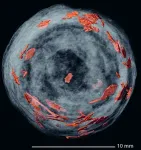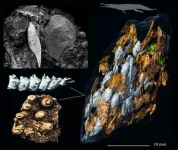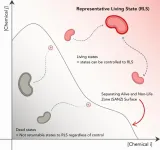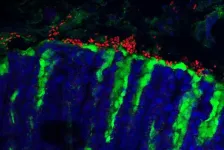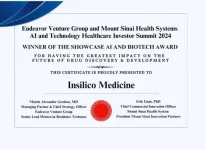(Press-News.org) In an international collaboration, researchers at Uppsala University have been able to identify undigested food remains, plants and prey in the fossilised faeces of dinosaurs. These analyses of hundreds of samples provide clues about the role dinosaurs played in the ecosystem around 200 million years ago. The findings have been published in the journal Nature.
“Piecing together ‘who ate whom’ in the past is true detective work,” says Martin Qvarnström, researcher at the Department of Organismal Biology and lead author of the study. “Being able to examine what animals ate and how they interacted with their environment helps us understand what enabled dinosaurs to be so successful.”
Palaeontologists from Uppsala University, in collaboration with researchers from Norway, Poland and Hungary, have examined hundreds of samples using advanced synchrotron imaging to visualise the hidden, internal parts of the fossilised faeces, known as coprolites, in detail. By identifying undigested food remains, plants and prey, they have recreated the structure of the ecosystems at the time when dinosaurs began their success story.
The study focused on a previously underexplored region, Polish Basin, located in the Late Triassic time in the in the northern parts of the then supercontinent Pangea. The researchers built up a comprehensive picture of the Triassic and Jurassic ecosystems (from about 230 to 200 million years ago) by combining the information from the coprolites with climate data and information from other fossils: plants, bite marks, vomit, footprints and bones.
“The research material was collected over a period of 25 years. It took us many years to piece everything together into a coherent picture,” says Grzegorz Niedźwiedzki, researcher at the Department of Organismal Biology and the study’s senior author. “Our research is innovative because we have chosen to understand the biology of early dinosaurs based on their dietary preferences. There were many surprising discoveries along the way.”
The coprolites contained remains of fish, insects, larger animals and plants, some of which were unusually well preserved, including small beetles and semi-complete fish. Other coprolites contained bones chewed up by predators that, like today’s hyenas, crushed bones to obtain salts and marrow. The contents of coprolites from the first large herbivorous dinosaurs, the long-necked sauropods, surprised the researchers. These contained large quantities of tree ferns, but also other types of plants, and charcoal. The palaeontologists hypothesise that charcoal was ingested to detoxify stomach contents, as ferns can be toxic to herbivores.
The research addresses a significant gap in current knowledge: the first 30 million years of dinosaur evolution during the Late Triassic period. Although much is known about their lives and extinction, the ecological and evolutionary processes that led to their rise are largely unexplored. The study results in a five-step model of dinosaur evolution that the researchers believe can explain global patterns.
The team emphasises that understanding how the first dinosaurs achieved their success can offer valuable insights into prehistoric ecosystems and evolutionary processes in general. The results show that dietary diversity and adaptability were crucial survival traits during the environmental changes of the Late Triassic.
“Unfortunately, climate change and mass extinctions are not just a thing of the past. By studying past ecosystems, we gain a better understanding of how life adapts and thrives under changing environmental conditions,” says Qvarnström.
“The way to avoid extinction is to eat a lot of plants, which is exactly what the early herbivorous dinosaurs did. The reason for their evolutionary success is a true love of green and fresh plant shoots,” Niedzwiedzki concludes.
END
Fossil dung reveals clues to dinosaur success story
2024-11-27
ELSE PRESS RELEASES FROM THIS DATE:
New research points way to more reliable brain studies
2024-11-27
Brain-wide association studies, which use magnetic resonance imaging to identify relationships between brain structure or function and human behavior or health, have faced criticism for producing results that often cannot be replicated by other researchers.
A new study published in Nature demonstrates that careful attention to study design can substantially improve the reliability of this type of research. For the study, Kaidi Kang, a biostatistics PhD student, Simon Vandekar, PhD, associate professor of Biostatistics, and colleagues analyzed data from more than 77,000 brain scans across 63 studies.
The ...
‘Alzheimer’s in dish’ model shows promise for accelerating drug discovery
2024-11-27
A decade ago, researchers introduced a new model for studying Alzheimer’s disease. Known as “Alzheimer’s in a dish,” the model uses cultures of mature brain cells suspended in a gel to recapitulate what takes place in the human brain over 10 to 13 years in just six weeks. But does the model truly produce the same changes that take place in patients? In a new study, researchers from Mass General Brigham, in collaboration with colleagues at Beth Israel Deaconess Medical Center (BIDMC), created an algorithm to assess, in an unbiased manner, how well models of Alzheimer’s disease ...
Ultraprocessed food intake and psoriasis
2024-11-27
About The Study: The results of this study showed an association between high ultraprocessed food intake and active psoriasis status. After adjustments for age, body mass index (BMI), alcohol intake, and comorbidities, the results remained significant, suggesting that ultraprocessed food intake has a proinflammatory action separate from high BMI.
Corresponding Author: To contact the corresponding author, Emilie Sbidian, MD, PhD, email emilie.sbidian@aphp.fr.
To access the embargoed study: ...
Race and ethnicity, gender, and promotion of physicians in academic medicine
2024-11-27
About The Study: The findings of this study indicate that preferential promotion of white men within academic medicine continues to persist in the new millennium, with racially and ethnically diverse women experiencing greater underpromotion. To achieve a workforce that reflects the diversity of the U.S. population, this study suggests that academic medicine needs to transform its culture and practices surrounding faculty appointments and promotions.
Corresponding Author: To contact the corresponding author, Lauren Clark, MS, email lclark5@kumc.edu.
To access the embargoed study: ...
Testing and masking policies and hospital-onset respiratory viral infections
2024-11-27
About The Study: In this study, stopping universal masking and SARS-CoV-2 testing was associated with a significant increase in hospital-onset respiratory viral infections relative to community infections. Restarting the masking of health care workers was associated with a significant decrease.
Corresponding Author: To contact the corresponding author, Theodore R. Pak, MD, PhD, email tpak@mgh.harvard.edu.
To access the embargoed study: Visit our For The Media website at this link https://media.jamanetwork.com/
(doi:10.1001/jamanetworkopen.2024.48063)
Editor’s ...
A matter of life and death
2024-11-27
Cellular death is a fundamental concept in the biological sciences. Given its significance though, its definition depends on the context in which it takes place, and lacks a general mathematical definition. Researchers from the University of Tokyo propose a new mathematical definition of death based on whether a potentially dead cell can return to a predefined “representative state of living,” which are the states of being that we can confidently call “alive.” The researchers’ work could be useful for biological researchers and future medical research.
While it’s ...
Huge cost savings from more efficient use of CDK4/6 inhibitors in metastatic breast cancer reported in SONIA study
2024-11-27
On November 27, the prestigious journal Nature will publish the results of an innovative breast cancer research project from the Netherlands. This study, the SONIA trial, showed that delaying and shortening the duration of a specific anti-cancer therapy (CDK4/6 inhibitors) in patients with hormone receptor-positive advanced breast cancer leads to similar survival outcomes, while reducing toxicity and achieving substantial cost reductions: over 45 million euros per year in the Netherlands and over 5 billion dollars in the United States. This is the first time an efficiency study like this has been conducted in collaboration with Dutch health ...
What a gut fungus reveals about symbiosis and allergy
2024-11-27
A fungus discovered in the mouse stomach may hold a key to fungal evolution within the gastrointestinal tract, according to new research led by Weill Cornell Medicine investigators. The finding suggests that preclinical studies until now have overlooked a major influencer of mouse physiology.
Scientists recently have come to appreciate the importance, for human health and disease, of microbes—often called “commensals”—that naturally dwell in the gut. Bacterial commensals, for example, are known to have ...
Insilico Medicine recognized by Endeavor Venture Group & Mount Sinai Health System with Showcase AI and Biotech Innovation Award
2024-11-27
Insilico Medicine (“Insilico”), a clinical-stage generative artificial intelligence (AI)-driven drug discovery company, is proud to be recognized for the impact on the future of drug discovery and development, as a distinguished honoree of the Showcase AI and Biotech Innovation Award on November 13, 2024, at the Fifth Endeavor Venture Group & Mount Sinai Health System Healthcare AI and Technology Investor Summit. Michelle Chen, Ph.D., Chief Business Officer of Insilico Medicine, received the award on behalf of the company.
Delivered ...
ESMO Asia Congress 2024: Event Announcement
2024-11-27
Lugano, Switzerland, 27 November 2024 – The ESMO Asia Congress 2024 is the annual event dedicated to multidisciplinary oncology in the Asian region. It will feature a broad spectrum of topics in cancer research, including novel treatment modalities, in-depth discussions on the management of specific cancer types, pan-Asian trials and subgroup analyses of cutting-edge studies relevant for the patients in the area. Data will be presented and discussed by leading experts from across Asia and beyond. The congress will be held onsite in Singapore from 6-8 December, with no virtual option available.
Programme highlights
Subgroup ...

